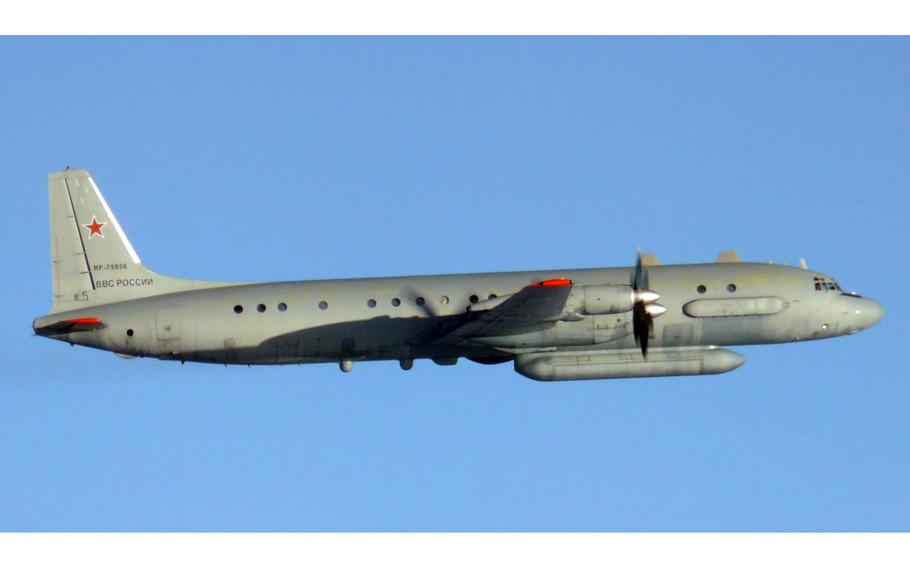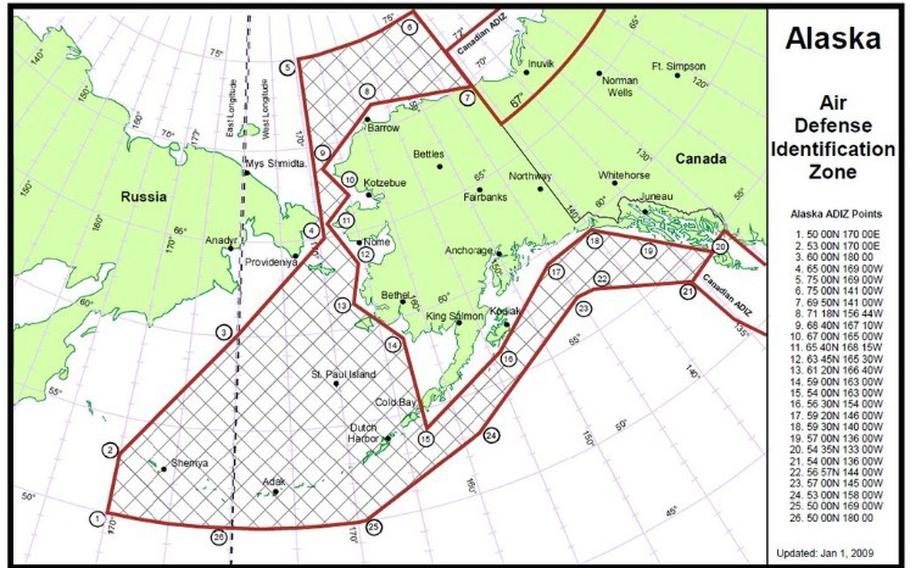
A Russian Ilyushin IL-20M surveillance plane flies near Japan on Feb. 12, 2025. It’s the type of reconnaissance plane seen by NORAD on Tuesday during the most recent Russian incursions into the Alaskan Air Defense Identification Zone — a buffer zone established between the US and Canadian borders and nearby international airspace. (Japan Air Self-Defense Force)
American aircraft intercepted a Russian surveillance flight Tuesday off the coast of Alaska for the fifth time in the past week, defense officials said Wednesday.
An Ilyushin IL-20 surveillance aircraft flew into the Alaskan Air Defense Identification Zone, according to the North American Aerospace Defense Command, the joint U.S.-Canadian air defense operation based at Peterson Space Force Base in Colorado.
National borders extend 12 miles from land under international law. The ADIZ is an additional buffer zone of up to 150 miles into international airspace created by the U.S. and Canada in which visual identification of all aircraft is required.
NORAD responded by scrambling two F-16 Fighting Falcon fighters, one E-3 Sentry surveillance plane, and one KC-135 Stratotanker refueling tanker to make visual contact with the Russian IL-20, a type given the NATO nickname “COOT.”
“The IL-20 flew inside the ADIZ for approximately two hours and 20 minutes — the closest point of approach to the U.S. mainland was 26 nautical miles north of Shemya Island,” said Canadian Armed Forces Capt. Rebecca Garand, a NORAD spokeswoman in Colorado.
Shemya Island is one of the far western Aleutian Islands, about 1,500 miles from Anchorage. Though 2,300 miles from the nearest major Russian city, Vladivostok, the island is only a few hundred miles from northern islands that are part of Russia.
NORAD said the Russian military aircraft remained in international airspace and did not enter the sovereign airspace of the United States or Canada.
“This Russian activity in the Alaskan ADIZ occurs regularly and is not seen as a threat,” NORAD said Wednesday in a statement.
NORAD has logged incursions into the zone on Aug. 20, 21, 22, 24 and 26.
The Alaskan zone stretches from the west end of the Aleutian Islands chain, across the Alaska and Canadian mainland, where it joins with the Canadian zone, which extends to St. Lawrence Island in the east.
The flurry of Russian flights into Alaska zone began five days after a meeting between President Donald Trump and Russian President Vladimir Putin at Joint Base Elmendorf-Richardson in Alaska to discuss ending the war in Ukraine.
Russia and China have increased their military activity in the Arctic region in recent years as climate change has opened up far northern waterways to military and commercial shipping. Russia and China operated a joint flotilla through the 51-mile-wide Bering Strait that separates eastern Russia and Alaska.

The Alaskan Air Defense Identification Zone. (U.S. Federal Aviation Administration)
Other recent Russian flights near Alaska were tracked on July 22, July 24, April 14, Feb. 18 and 19.
American and Canadian aircraft were also sent to monitor Russian aircraft over the Arctic on Jan. 30, though NORAD did not specify whether they entered the Alaska zone.
NORAD recorded 12 flights into the zone by Russian planes during 2024.
“Since Russia resumed long-range aviation activities in 2007, the number of incursions fluctuates annually, but we have seen as many as 15 in one year to as low as zero,” Garand said.
The U.S. and Canada use satellites, radar, and patrolling aircraft to monitor incursions, she said.
The IL-20 is a Soviet-era electronic intelligence and reconnaissance turboprop aircraft, developed from the IL-18 turboprop airliner that first flew in March 1968.
The aircraft typically carries a crew of up to 12, including mission specialists in battlefield surveillance, electronic intelligence and signal intelligence. The IL-20 typically carries infrared and optical sensors, side-looking radar, antennas to intercept radio and radar signals from aircraft, and secure communications systems that link it to its controllers on the ground.
On July 17, 2024, NORAD detected a large formation of Russian TU-95 “Bear” and two Chinese Xi’an H-6 “Badger” long-range patrol aircraft. The H-6 is a Chinese licensed version of the Soviet-era TU-16 “Badger” that first flew in 1952. NATO uses the same identification nickname for both aircraft.
The TU-95 and H-6 are both capable of carrying offensive weapons, including bombs and cruise missiles, in some configurations.